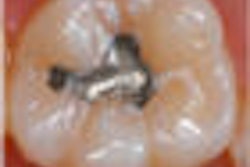The type of surface that dental adhesive clings to during a crown's bonding process plays an important role in the strength of that bond, according to researchers from Case Western Reserve University.
By using an x-ray photoelectron spectroscopy imaging system, Jin-Ho Phark, D.D.S., D.M.D., an assistant professor of comprehensive care at the university's School of Dental Medicine, was able to detect what contaminants cling to the crown surface. This research overturns the thinking about what is the gold standard in placing crowns, he said in a press release.
The plaster contamination that can occurring during the veneering process of a crown -- along with saliva and blood during the fitting procedure before permanently attaching the crown -- can cause gaps in the adhesive between the tooth and crown, and weaken the bond, Dr. Phark said. Over time, secondary decay can occur at the margin of the crown or weakness can develop as the crown ages.
The gold standard in attaching aluminum- and zirconium-oxide crowns has been to blast the interior of the crown with sand particles to roughen the surface, then to attach it with a special cement, Dr. Phark said. But sandblasting may weaken the ceramic material.
He tested a new ceramic crown material, developed by Nobel Biocare, that is fabricated in a new heating process to create a very rough surface texture on the inside of the crown where the bond agent is applied before affixing the crown to the tooth. Plaster or blood and saliva can become trapped in the valleys of the new surface. But during the veneering procedure, excess plaster particles are burned off to prevent contamination. The etching of the interior crown surface with an acid before attaching it to the tooth also removes the blood and saliva.
"This new crown comes prepared and does not need the extra sandblasting treatment by a dental technician," Dr. Phark said. It can also be attached with normal cements.
Dr. Phark's research won this year's International Association for Dental Research (IADR) award for new investigators in the area of biomaterials.
Copyright © 2009 DrBicuspid.com



















